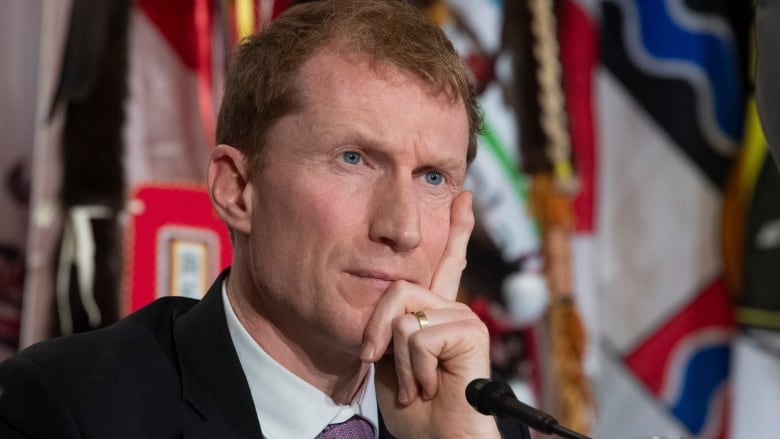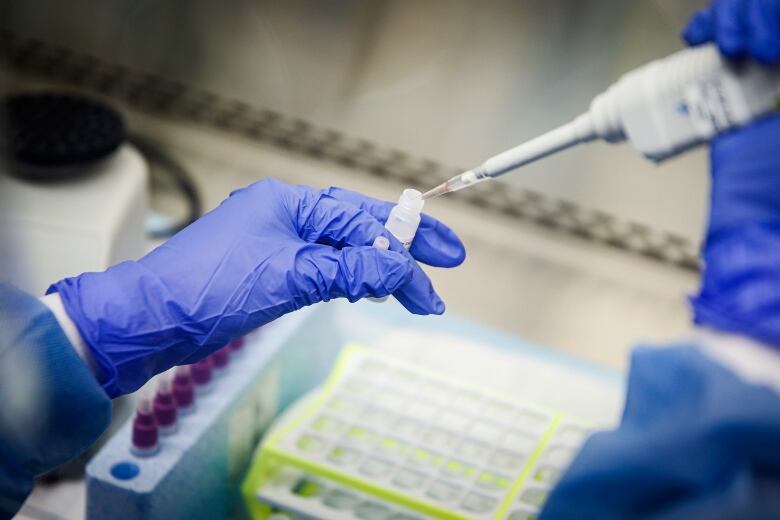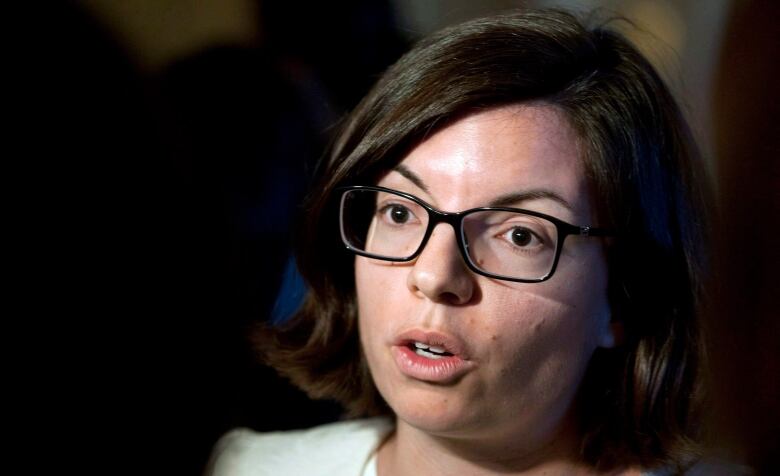Ottawa preparing isolation tents for COVID-19 outbreak in Indigenous communities
Isolation tents, field hospitals part of possible response to COVID-19 outbreak in remote communities

The federal government is prepared to use isolation tents and temporary shelters to deal with the threat of an outbreak of COVID-19 in Indigenous communities, according to a senior department official.
Valerie Gideon, senior assistant deputy minister for the First Nations and Inuit Health Branch, said the Public Health Agency of Canada isworking on procuring specialized isolation tents for screening and testing that could be used in communities that lack adequate infrastructure to deal with COVID-19, which has been declared a pandemic by the World Health Organization.
"We are looking to procure some of these tents in order to be able to deploy them rapidly as needed," Gideon said.
"If they have a very small health centre for instance, we have communities that have a nursing station with only two or three nursing staff, so it's very limited in terms of space. So that would be an area where we may deploy a tent."
Gideon said the specialized tents, which measure about six by five metres,create a "negative pressure" environment conducive to screening and testing.

Indigenous Services Minister Marc Miller said the acquisition of specialized equipment such as isolation tents is part of the government's tailored approach to the specific needs of remote Indigenous communities.
"It's part of a distinctions-based approach we have to make for communities where [there] is a risk to further spread COVID-19 should that occur," Miller said.
Many remote First Nation and Inuit communities face housing shortages and overcrowding, with multiple families sharing a single home. Many Indigenous communities alsolack of clean drinking water and have limited access to medical services, making themparticularly vulnerable to an outbreak and making self-isolation one of the key measures for dealing with COVID-19 difficult to accomplish, according to the department.
Use of field hospitals a possibility
In addition to tents, Gideon said the department is also prepared to ship lightweight structures to house people who need to self-isolate, and to provide accommodations for any additional health workers who may need to be sent to Indigenous communities facing an outbreak.
"If you're having additional service providers who are going to fly into communities, there's not necessarily a place to stay. The nursing station residences will be full. People's homes may not be an option ... The hotels may be full," Gideon said.
"We're looking at temporary shelter solutions that would have a heating component as well as a heating source."

Gideon said the department is considering initiating emergency deployments of temporary shelters as the season for winter roads which serve many remote communities nears its end.
The possible need for field hospitals also has been raised in discussions on preparing for a COVID-19 outbreak in remote communities, but Gideon said this is a discussionthat needs to include provincial health departments.
"It is something that has been raised very, very recently," Gideon said.
"We will be talking to provincial governments to see if that's part of what they're looking at in terms of their pandemic plans."
The last time Indigenous communities asked for help to prepare for a pandemic, Health Canada sent more than two dozen body bags to a Manitoba First Nation during the H1N1 outbreak, known as the swine flu.
Much has changed since that 2009 mishap, which forced Health Canada to apologize to Wasagamack First Nation.
The need for field hospitals was also raised during the H1N1outbreak, which led Manitoba First Nations to declare a stateof emergency. Since most remote Indigenous communities only have a nursing station or a small medical centre, people who fell sick at the time were sent to cities via air ambulances to be treated in hospitals already dealing with the local population.
National Indigenous leaders concerned
Indigenous leaders were hoping to discuss the response to COVID-19 during a planned First Ministers meeting Thursday in Ottawa, but it was postponed after the Prime Minister's Office announced Prime Minister Justin Trudeau's wife Sophie Grgoire Trudeau had been tested for the virus. The prime minister has decided to self-isolate and work from his residence.
Indigenous leaders say a teleconference with Trudeau has been scheduled for Friday, but the premiers won't be involved in those talks.
Assembly of First Nations National Chief Perry Bellegarde said COVID-19 poses a potentially deadly threat to remote First Nation communities.
"If they don't get the care, there will be deaths," Bellegarde said.
"There will be high numbers because it's just going to spread rampant. That's my biggest fear."
Bellegarde tweeted Thursday afternoon that the AFN has suspended all staff travel and cancelled scheduled meetings and conferences as a result of the pandemic.
"National Chief Bellegarde is very aware of the concerns and cautions around the current situation," said the AFN in a statement sent to CBC News Thursday afternoon.
"He will continue to reach out to federal, provincial and territorial leaders and officials with the immediate and primary objective being to ensure all levels of government have prevention and response plans in place for the COVID-19 coronavirus that address the unique situation of First Nations."
Natan Obed, president of the Inuit Tapiriit Kanatami the national organization representing Inuit said a lack of infrastructure and adequate health services leaves many Inuit communities vulnerable to the type of outbreak currently unfolding across the globe.
"As a respiratory illness, COVID-19 poses a specific threat to Inuit because of things like overcrowding and lack of infrastructure and lack of health care," he said.
Obed said some Inuit organizations already have begun to curb travel and make alternatearrangements for meetings as a result of the pandemic. Obed said his organization is working closely with the Public Health Agency of Canada and Indigenous Services to deal with the specific needs of the 51 Inuit communities spread across the Inuit homelands.
The national Inuit leader said he was looking forward to discussing with Miller the department's plans for the use of specialized medical tentsin Inuit communities.
"There are Inuit specific considerations within any of the work the federalgovernmentdoes to react to COVID-19," he said.
On Wednesday, Trudeau announced his government was putting $1 billion toward dealing with the pandemic. Funding for Indigenous communities was earmarked to come out of a $100 million envelope.

However, the Mtis won't be able to access any of the funding because it's only availablefor First Nations and Inuit, who fall under federal health care jurisdiction, said David Chartrand, vice-president of the Mtis National Council.
"Canadians will get help, everyone else will get help, the First Nation, Inuit, except us,"Chartrandsaid.
Chartrand, who is also president of the Manitoba Mtis Federation, said the Manitoba provincial government is ignoring the needs of Mtis and they need the federal government to step in and fill the funding gap.
The Manitoba Mtis Federation has bought three small mobile homes and is refurbishing two 48-bed camps it owns to create quarantine spaces for Mtis citizens, he said.
"You have a particular premierwho's taken an individual view in opposition of a certain group of people and won't do anything for them then where do we turn?" Chartrand said.
Chartrand said the Mtis National Council and the federation have also curtailed staff travel, postponed meetings and cancelled gatherings as a result of the COVID-19 outbreak.
Infection rate in remote Indigenous communities unclear
NDP MP Niki Ashton, whose riding of Churchill-Keewatinook Aski includes several northern Manitoba First Nations, said the use of specialized medical tents won't meetthe needs faced by northern Indigenous communities.
"Anywhere in northern Canada, for the next three months, is notthe kind of climate where tents of any kind can be used for people who get sick,"Ashtonsaid.

Ashton said First Nation leaders in her riding say they are hearing very little directly from the federal government about its plans.
"We need to get real about the First Nations reality, and that's not what we are hearing from this governmentand that has to change very quickly. People will get very sick," she said.
"Everybody on the ground that I'vebeen talking to is very concerned about what could happen to their community."
Gideon said the department is ready,plans are in place to deal with the pandemic and officialsarenow in continual communication with communities to deal with the rapidly changing landscape COVID-19 is creating.
"There's flexibility in the government's approach to ensure that resources will be available where they are needed and that we do not have a shortage with respect to supplies or testing capacity," Gideon said.
The department is ensuring that health workers in communities have the supplies they need, from protective masksto hand sanitizers, according to Gideon.
She said it's not clear at the moment what the potential infection rate could be if it hits remote Indigenous communities.
"I mean, you could look at a 35 per cent type rate of potential But I think it's highly variable," she said.
"It's important also to remember that the overall Indigenous population is a younger population. So far, for the moment, we've seen [with] COVID-19 not many children have been impacted That also is important to remember in terms of probability."












_(720p).jpg)


 OFFICIAL HD MUSIC VIDEO.jpg)
.jpg)



























































































